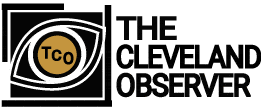|
|
By Erin Randel, Circular Cleveland Ambassador
Ren Brumfield works for City Hall, but he does not work at City Hall.
He’s helming the rebirth of Cleveland’s Residential Recycling Program from a green-tinted office in the Carr Center, a municipal garage and vehicle maintenance facility at the southeast corner of Carnegie and E. 55th. It is where most of the east side garbage trucks hang out and get their baths when they’re not on the road.
Carr Center, a municipal garage and vehicle maintenance facility at the southeast corner of Carnegie and E. 55th. It is where most of the east side garbage trucks hang out and get their baths when they’re not on the road.
Brumfield is new to the role of Recycling Coordinator, and the role is new to the city, but he is not new to Cleveland. A native of Houston, he comes to the job after two and a half years as the Waste Management Coordinator at MetroHealth. Bromfield spent eight years with University Hospitals before that. He earned his Associate’s degree in Environmental Health and Safety from Tri-C, and a Bachelor of Science degree in Environmental Management from Columbia Southern University.
His work in healthcare has been a mix of frontline compliance work, and upstream culture change.
“I helped all the different departments dispose of their waste – red bag/infectious, pharmaceutical waste, drugs/meds, controlled substances – to be in compliance,” with federal and state regulations. He also worked upstream with those with purchasing power to think about the end of the useable life of the items they were ordering.
 “There are lots of work-around ways to reduce waste from the very beginning, before the purchase is even made.”
“There are lots of work-around ways to reduce waste from the very beginning, before the purchase is even made.”
When he saw the city job posting, he felt like it had been written from his résumé. “Why not take a chance and do what I can to change things?” he wondered.
Coming into this role last October gave him an opportunity to finalize the RFPs (Request for Proposals) from recycling processors, with an eye toward re-introducing the city’s recycling program, not as something put upon residents, but an opportunity to build with them.
He’s not worried that only about 20%—about 27,000 of 150,000 households served by the Division of Waste Collection—have opted in ahead of the relaunch.
“There’s a dynamic in the community, ‘I’ll believe it when I see it.’ There’s a lot of that going on, so we have an opportunity for more buy-in, and an opportunity to feel like it’s something that they own in the community. As we build it and show them that it’s here, it’s real, then they’ll take the opportunity. Seeing it up and running will bring people a whole different perspective.”
As of this writing, three bids had been submitted to haul and process recycling, and Brumfield had made a recommendation that was pending approval. Once a contract is signed, packets will be sent to the households of those who signed up during the initial enrollment period last fall. The packets will explain which materials should be included in their blue carts, and how to set them outside.
a recommendation that was pending approval. Once a contract is signed, packets will be sent to the households of those who signed up during the initial enrollment period last fall. The packets will explain which materials should be included in their blue carts, and how to set them outside.
Brumfield’s goal is to get a good recycling program going, including as many household materials as possible: glass jars, metal cans, paperboard, coated paper cartons, plastic bottles, jugs, and tubs; and to have them processed into new products by companies located in Ohio, and nearby states.
On the vendor side, the implementation should be simple–they only have to collect the material from the Ridge Road Transfer Station, since city employees will continue to collect waste on the neighborhood routes.
The real work will be getting the word out among residents
“It’s a unique opportunity to stop, refresh and restart this whole process. We can make it really, really good. It starts with me getting the word out, making it understandable, and answering their questions,” he said. For that, he’s happy to have the support of Cuyahoga County Master Recyclers, and the Circular Cleveland Initiative.
“Recycling is for everyone. We can all recycle. If you drink a bottle of water or a can of pop, or eat some food, you’ll probably have something you can recycle.”
The biggest challenge? Wishcycling 
People mean well, and they recycle things that just can’t be handled by the recycling system they’re using. “One key is to stop going by the resin codes” often stamped on the bottom of packaging. “That only tells you the chemicals in the item, not whether they’re recyclable by the processor that you’re dealing with.”
Best Resource
CuyahogaRecycles.org, offers directions on where to take any waste or items that don’t fit the single-stream residential program, and master recyclers help with outreach. CuyahogaRecycles.org
What’s the most important thing to know?
“All of our waste isn’t garbage.
Waste is just something you’re done with, that you don’t have any further use for. Garbage is something that needs to go into a landfill. It’s forever. So recycling is just part of waste management. Some of it is, ‘don’t buy that disposable thing, buy something you can use again, or donate to someone else to use.’ ”
Start with little changes
“Have an extra trash can in the house that’s just dedicated for recyclables. Do you just go outside every time you drink a can of pop?”
Make it easier to keep the recycling and landfill items separate, then tip the recycling trash can—loose [no plastic bags]—into the blue Recycling cart when it’s full.

